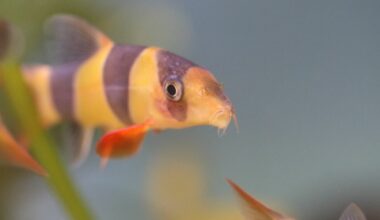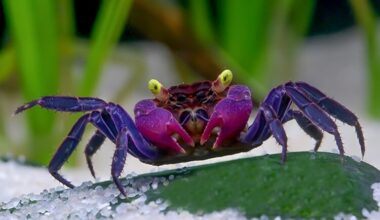Putting lucky bamboo in aquariums is a topic that aquarists have debated for quite some time.
Is it possible? What conditions are best? Can this plant bring any benefits to the tank?
These are all questions that have been kicked around, so we wanted to put together the definitive resource on using lucky bamboo in fish tanks. It covers everything you need to know!
Table of Contents
Plant Summary
Lucky bamboo (Dracaena sanderiana) is a common houseplant that you often see growing in tiny water-filled vases. It’s also a beloved plant in the aquarium world that can add a unique Asian twist to your tank decor. However, lucky bamboo is not Asian at all!

Despite its Eastern influence, lucky bamboo comes from Cameroon in Central Africa. It’s not the same as traditional bamboo. The tall and structural grass most are familiar with does not grow in water at all. Lucky bamboo is a unique variety that’s built to withstand seasonal flooding and dry spells.
There’s a lot of confusion regarding the efficiency and safety of lucky bamboo in aquariums. But it’s actually not very hard to keep this beautiful plant healthy and thriving!
The Benefits Of Having It In Your Tank
From an aesthetic standpoint, lucky bamboo is one of the most unique plants you can have! It’s tall, thick, and sturdy. This means that unlike other underwater plants, this one isn’t going to move with the natural water flow. It remains stationary and creates a fun network of paths for your fish to navigate.
Author Note: On top of all that, it provides a stunning backdrop that you can use to create a themed environment!
On a more practical level, lucky bamboo can improve the overall aquarium conditions. Contrary to popular belief, this plant doesn’t rot inside or poison the tank. It does quite the opposite!
As it grows, lucky bamboo pulls nitrates from the water and uses them as fuel to grow! As a result, your aquarium stays cleaner and healthier for any inhabitants. Plus, the plant will help increase oxygen levels and provide some physical shelter for shyer fish.
Appearance
Lucky bamboo is actually a form of grass. It looks strikingly similar to traditional bamboo, growing in tall stocks with visible nodules. The main difference with this particular cultivar is that it has fleshy stalks with waxy tops. This trait makes the plant more tolerant of wet environments.
The plant sprouts many leaves from its sides. The color of the leaves is the same as the stalks, which varies from deep green to borderline yellow.
Generally, the base of the plant is straight and sturdy. You may notice tiny tendrils of roots sprouting from the bottom. Up top, the plant may grow in all kinds of directions.
Author Note: Some aquascapers train the plant to take on a specific shape. You might see spirals, zigzags, or a more natural sporadic pattern.
Size & Growth Rate
When you first buy this plant, they usually come in small shoots that are only a few inches tall. However, the lucky bamboo plant is capable of growing to four feet tall or more!
Its mature height will depend entirely on where it grows and how much space it has. The same goes for the growth rate.
For the most part, lucky bamboo is a slow grower, but you can speed up or slow down its growth rate by adjusting environmental conditions. With ample light and a decent amount of fertilizer, the shoots will soar! However, standard tank conditions tend to make its development pace more modest and manageable.
Lucky Bamboo Care
Despite all the misinformation out there, lucky bamboo care is pretty easy. It comes from harsh African environments with constantly fluctuating conditions. If it can hold up there, it can flourish in a controlled aquarium!
Of course, the plant has its ideal conditions. Lucky bamboo is a bit of a unique plant, so meeting its needs is more important than ever!
Tank Size
To have stable water conditions, you need a tank that can hold at least five gallons. A five-gallon aquarium is enough to support a small cluster of shoots.
But if you want to take full advantage of lucky bamboo’s beauty, go bigger! Larger aquariums will allow you to fully submerge the plant or continue its growth beyond the water’s surface.
Water Parameters
Interestingly enough, lucky bamboo is not a true aquatic plant. Nevertheless, it can grow well both partially and fully submerged. Because of this, it’s very important to know what the ideal water conditions are.
Fortunately, this plant adapts well to most tank setups. It’s actually so flexible that most aquarists focus more on their fish’s preferred parameters than the plant’s. As long as you stick to the following, you should be fine.
- Water temperature: 59°F to 80°F
- ph levels: 6.0 to 6.5
- Water hardness: 0 to 8 dGH (Soft water)
Author Note: Make sure you have a good water test kit for your aquarium in order to easily monitor these parameters.
Lighting
Lucky bamboo does best in low to moderate lighting.
Author Note: In its natural habitat, lucky bamboo has to deal with diffused light. It grows below broad-leaf plants that cast a shadow onto it.
A bit more exposure can speed up its growth rate. However, too much will cause serious trouble. Excessive light will burn the leaves and cause massive discoloration throughout.
Like most plants, a typical day and night lighting cycle is preferred.
Lucky bamboo can grow well near a window with natural sunlight. If you choose to use artificial light, set a timer to make sure that it has low exposure for 10 to 12 hours a day.
Substrate
You can plant lucky bamboo with or without substrate. The best choice for you will depend entirely on the inhabitants of your tank.
Technically speaking, this plant doesn’t need substrate at all to continue growing. All they need is two to three inches of water.
But if you plan on keeping the plant with fish and invertebrates, that’s a completely different story! In aquariums teeming with life, substrate materials will keep the roots protected and safe.
The ideal substrate is coarse gravel or loose pebbles. You can utilize nutrient-rich aquatic soils, but those materials can easily compact around the roots and create dead growth zones.
Loose substrate promotes proper water flow around the roots.
Author Note: It’s best to bury lucky bamboo deep. Most agree that you need around four inches of substrate material to truly anchor the plant in.
How To Plant It
As mentioned earlier, there are two ways to grow lucky bamboo. You can either partially or fully submerge it.
There’s no right or wrong method.
With partial submersion, you have a little more wiggle room. The goal here is to keep the leaves and upper growth out of the water. To do this, choose a mature specimen with ample length. Then, bury about four inches into the substrate and fill the tank to about an inch below the lowest leaf set.
If you want to submerge the entire plant, you might need to be a bit more vigilant about creating a conducive growing environment. The stalk and leaves will do fine underwater. But, you must ensure that the plant is getting all the nutrients it needs.
When submerged, lucky bamboo prefers high levels of oxygen and moderate to high carbon dioxide. You can address the oxygen issue with air bladders or more vigorous churning from your filter. For carbon dioxide, you can try liquid dosing or CO2 canisters.
Trimming & Pruning
The amount of trimming you do on your lucky bamboo is entirely optional.
This plant doesn’t spread horizontally, so it’s easy to manage. The only issue you might have is with vertical growth.
Thanks to the slower growth rate, you may only need to trim the plant once or twice a year. To remove unwanted growth, cut just above one of the defined nodes. The nodes are the rings that separate the individual bamboo sections.
Tank Mates
The best thing about lucky bamboo is its wide compatibility with fish and invertebrates. This plant is hardy!
Unlike pure aquatic plants, lucky bamboo is at a very low risk of being damaged when nibbled on. Your fish can try to chew on the stalks, but most aren’t going to make a dent! The only issue is with burrowing fish that are known to uproot plants. But even then, you can avoid the problem by burying the bamboo’s base deep.
Lucky bamboo is a good choice for most fish and inverts. Not only is it tough enough to withstand any unruly behavior, but its broad growth parameters give you tons of flexibility in choosing tank mates.
Some common lucky bamboo tank mates worth trying out include:
- Goldfish
- Cichlids
- Barbs (we recommend Cherry Barbs)
- Discus
- Molly Fish
- Many Types Of Tetras
- Angelfish
- Freshwater Catfish
- Guppy Fish
- Betta Fish
- Most Snails
- Most Freshwater Shrimp
- Freshwater Aquarium Crabs
- Crayfish
Because you can partially submerge lucky bamboo, it’s also a favorite for vivariums. It works well with frogs, turtles, and more!
Propagation
As your lucky bamboo matures, it will continue to produce offshoots. They appear at the various nodes and can get about half the girth of the primary stalk. Those offshoots make great propagated plants.
Before snipping them off, make sure your plant is healthy. Also, give the shoot some time to develop multiple leaf joints. All propagations should have at least one joint, but more joints are preferred.
Author Note: It’s also better to give the offshoot some time to grow long. Remember, this plant prefers to be submerged in several inches of water. They don’t tolerate dry roots. Giving the plant some time to grow will make it easier to anchor in a new home.
When the shoot is ready, trim back any leaves to expose the growth joint at the node. Then, use sharp scissors to cut the shoot off cleanly. Don’t saw it off or leave behind any jagged edges. Rough cuts only make it harder for the propagation and the original plant to heal.
To establish a new plant with the propagation, embed them in water. If possible, root them in the same tank as the original plant. The offshoot is already used to the conditions, so you eliminate the risk of transplant shock.
Anchor the cutting into the substrate just like you did with the original plant. Over time, it should develop its own root system. Check on it periodically to ensure that the base is not rotting.
Conclusion
As you can see, putting lucky bamboo in aquariums is something you shouldn’t be afraid to try. It can be a great inclusion if you have the right conditions and critters in the tank!
Let us know if there’s anything else about this plant that you’d like to learn. We’re more than happy to answer your questions directly!

